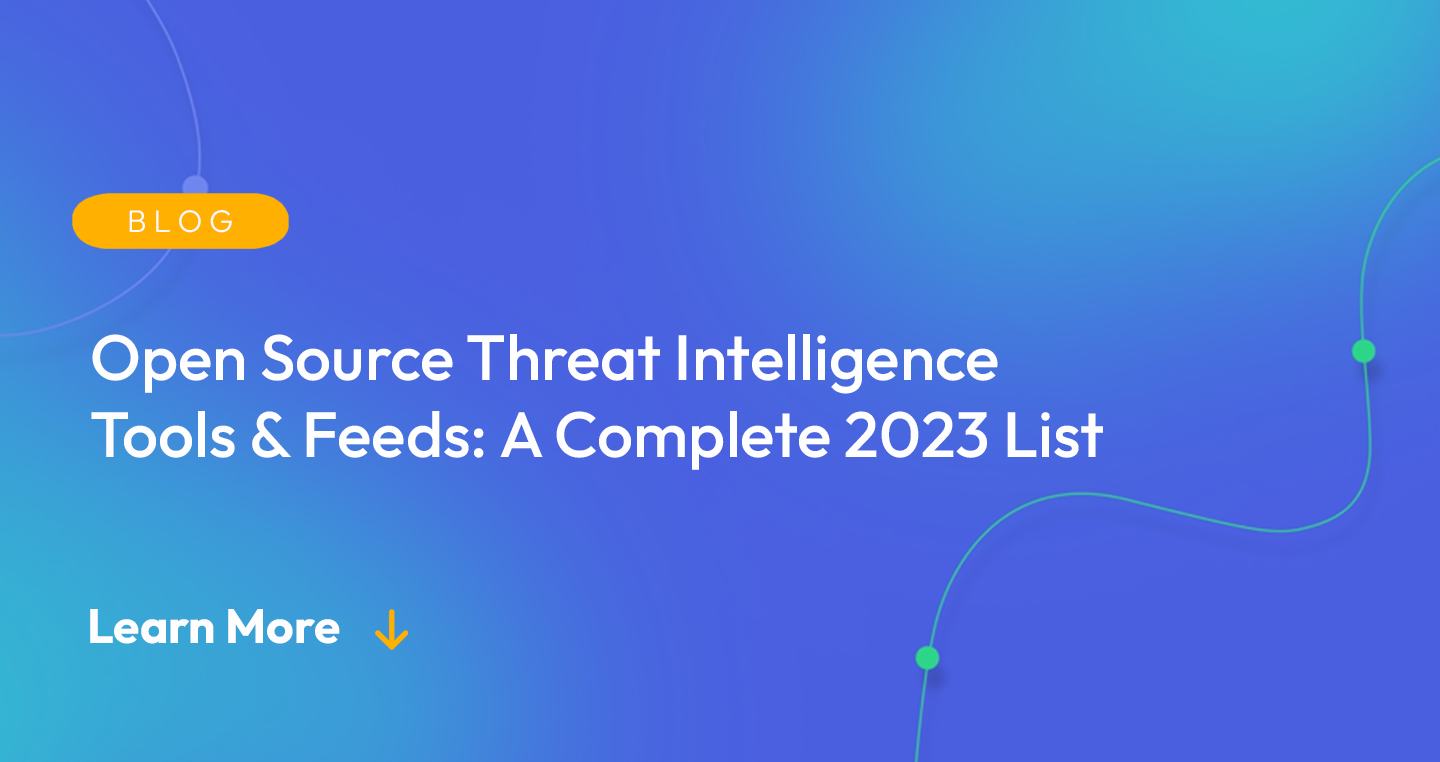
The rapidly evolving cyber threat landscape demands constant vigilance from organizations seeking to protect their digital assets. Open source threat intelligence tools and feeds have emerged as invaluable resources in this endeavor, offering insights into current trends, vulnerabilities, and threat actors. In this article, we will provide a comprehensive list of open source threat intelligence tools and feeds for 2023, equipping cybersecurity professionals and organizations with the information they need to stay one step ahead of potential cyber attacks and safeguard their systems and networks effectively.
Overview of Open Source Threat Intelligence Tools
Open source threat intelligence tools play a critical role in helping organizations stay informed about emerging cyber threats and vulnerabilities. These tools offer a wide range of capabilities, from data collection and analysis to visualization and reporting, empowering cybersecurity professionals to make well-informed decisions to bolster their defenses. In this section, we will provide an overview of some of the most popular and effective open source threat intelligence tools available in 2023.
TheHive: TheHive is a scalable, open source Security Incident Response Platform (SIRP) designed to facilitate collaboration and information sharing among security teams. With built-in integration with numerous threat intelligence feeds, TheHive allows organizations to effectively manage incidents and analyze threat data.
MISP (Malware Information Sharing Platform): MISP is a powerful open source platform for sharing, storing, and correlating Indicators of Compromise (IOCs) related to security incidents. It provides users with the ability to create, collaborate, and share threat intelligence within their organization and trusted communities.
Yeti: Yeti is an open source threat intelligence platform designed to help security analysts organize and contextualize threat intelligence data. With its user-friendly interface, Yeti enables users to manage indicators, observables, and other threat data, as well as integrate with various external sources of intelligence.
Cuckoo Sandbox: Cuckoo Sandbox is an open source automated malware analysis system that enables users to analyze suspicious files in an isolated environment. This tool offers valuable insights into the behavior of malware, helping security professionals identify potential threats and develop appropriate countermeasures.
OpenCTI (Open Cyber Threat Intelligence): OpenCTI is an open source platform for managing and analyzing cyber threat intelligence data. With its focus on automation, OpenCTI streamlines the process of collecting, storing, and correlating threat intelligence, helping organizations efficiently make sense of large volumes of data.
T-Pot: T-Pot is an open source honeypot platform that combines various honeypot technologies and threat intelligence tools to provide a comprehensive view of cyber threats. By deploying T-Pot, organizations can gain insights into attacker behavior and tactics, as well as identify emerging threats and vulnerabilities.
These open source threat intelligence tools offer a wide range of capabilities to assist organizations in staying ahead of the ever-evolving cyber threat landscape. By leveraging these tools, cybersecurity professionals can enhance their threat intelligence efforts, making more informed decisions and strengthening their overall security posture.
Comprehensive List of Open Source Threat Intelligence Feeds
In addition to open source threat intelligence tools, numerous open source threat intelligence feeds are available to provide organizations with valuable, up-to-date information on the latest cyber threats and vulnerabilities. These feeds serve as a vital resource for cybersecurity professionals, helping them stay informed about emerging threats and risks. Below, we have compiled a comprehensive list of open source threat intelligence feeds for 2023:
AlienVault Open Threat Exchange (OTX): AlienVault OTX is a global, community-driven platform that enables security researchers and professionals to share real-time threat intelligence. It provides information on Indicators of Compromise (IOCs), malware samples, and other threat data.
Cyber Threat Intelligence Network (CTIN): CTIN is a curated collection of cyber threat intelligence feeds that include data on vulnerabilities, malware, and phishing campaigns. This network of feeds helps organizations stay updated on the latest cyber threats.
Abuse.ch: Abuse.ch offers various feeds focusing on different aspects of cyber threats, such as botnets, malware, and ransomware. These feeds provide valuable information to help organizations identify and mitigate emerging threats.
CIRCL (Computer Incident Response Center Luxembourg) Passive DNS and Passive SSL: CIRCL provides several feeds, including Passive DNS and Passive SSL, which offer valuable information on domain names and SSL certificates associated with malicious activities.
Spamhaus: Spamhaus is a well-known organization that offers a variety of feeds related to spam, malware, and botnet command and control servers. Their data is useful for organizations looking to block known malicious IPs and domains.
PhishTank: PhishTank is a collaborative platform that allows users to submit, verify, and share phishing data. It provides an extensive feed of verified phishing URLs that can be used to protect organizations against phishing attacks.
Malware Domain List: The Malware Domain List is a community-driven feed that includes information about malicious domains involved in malware distribution, exploit hosting, and other cybercrime activities.
SANS Internet Storm Center (ISC): SANS ISC offers various feeds, including daily diaries on cybersecurity events, malicious IPs, and domain names associated with malicious activities. These feeds can help organizations stay informed about the latest threats and vulnerabilities.
This comprehensive list of open source threat intelligence feeds provides organizations with a wealth of information on the latest cyber threats and risks. By incorporating these feeds into their cybersecurity strategies, organizations can better understand the ever-evolving threat landscape and make informed decisions to protect their digital assets.
Evaluating the Effectiveness of Open Source Threat Intelligence Resources
While there are numerous open source threat intelligence tools and feeds available, not all resources are created equal. To make the most of these resources and ensure that your organization is receiving the most valuable and relevant intelligence, it’s essential to evaluate their effectiveness. In this section, we’ll discuss several factors to consider when assessing the quality and usefulness of open source threat intelligence resources.
- Timeliness: The rapidly evolving nature of cyber threats demands real-time or near-real-time updates on new vulnerabilities, malware, and threat actors. When evaluating a resource, consider the frequency of updates and ensure that the information provided is current and relevant.
- Relevance: The value of threat intelligence is directly tied to its relevance to your organization and industry. Focus on resources that offer insights into threats and vulnerabilities specific to your sector, as well as those that provide actionable intelligence, such as Indicators of Compromise (IOCs).
- Accuracy: Accurate threat intelligence is essential for effective decision-making and response. Assess the quality and reliability of the data provided by a resource, considering factors such as the source of the information and the process used for data validation.
- Completeness: Comprehensive threat intelligence should cover various aspects of cyber threats, from vulnerabilities and exploits to malware and phishing campaigns. When evaluating resources, ensure that they provide a holistic view of the threat landscape, addressing multiple dimensions of cyber risk.
- Ease of Integration: The ability to seamlessly integrate threat intelligence into your existing security infrastructure is crucial for maximizing its value. Look for resources that offer standardized formats, such as STIX or TAXII, which facilitate smooth integration with security tools and platforms.
- Community Involvement: Resources that promote collaboration and information sharing among security professionals can provide valuable insights and perspectives. Engaging with active, knowledgeable communities can enhance the quality of the threat intelligence you receive.
By considering these factors when evaluating open source threat intelligence resources, organizations can identify the most valuable and effective tools and feeds for their needs. This enables them to make more informed decisions and develop robust strategies to mitigate emerging cyber threats and protect their digital assets.
Integrating Open Source Threat Intelligence into Your Cybersecurity Strategy
Successfully integrating open source threat intelligence into your cybersecurity strategy is vital to staying ahead of emerging threats and protecting your organization’s digital assets. In this section, we’ll explore key steps and best practices for incorporating open source threat intelligence resources into your security approach.
- Identify Your Organization’s Needs: Before diving into the vast array of available threat intelligence resources, assess your organization’s specific needs and priorities. Consider factors such as your industry, the size of your organization, and the types of threats you are most likely to encounter. This will help you focus on the most relevant and valuable resources.
- Choose the Right Tools and Feeds: With a clear understanding of your organization’s needs, select the open source threat intelligence tools and feeds that align with your priorities. Consider factors such as timeliness, relevance, accuracy, and ease of integration when making your selections.
- Establish a Threat Intelligence Team: Assign a dedicated team within your organization to manage and analyze threat intelligence data. This team should be responsible for monitoring selected resources, evaluating the relevance and accuracy of the information, and communicating findings to relevant stakeholders.
- Integrate Threat Intelligence with Existing Security Infrastructure: To maximize the value of open source threat intelligence, integrate it with your existing security tools and platforms. Look for resources that offer standardized formats, such as STIX or TAXII, to facilitate smooth integration and data sharing across systems.
- Develop a Threat Intelligence Sharing Program: Collaborating and sharing information with other organizations in your industry can significantly enhance your understanding of emerging threats. Establish a program to share threat intelligence with trusted partners, and participate in industry-specific threat sharing communities and platforms.
- Continuously Evaluate and Adapt: The threat landscape is constantly evolving, and so should your threat intelligence strategy. Regularly assess the effectiveness of your chosen resources, and make adjustments as needed to ensure you’re staying informed about the most relevant and pressing threats.
By following these best practices for integrating open source threat intelligence into your cybersecurity strategy, your organization can effectively leverage these resources to stay ahead of emerging threats, make informed decisions, and ultimately protect your digital assets.
Flare and OSINT
Flare’s prioritized alerts cut out the noise to help guide your team in effective monitoring. With our AI Powered Assistant, automatically translate and contextualize illicit posts to take action even faster. Check out our free trial to see how our coverage can add to your OSINT practices.





